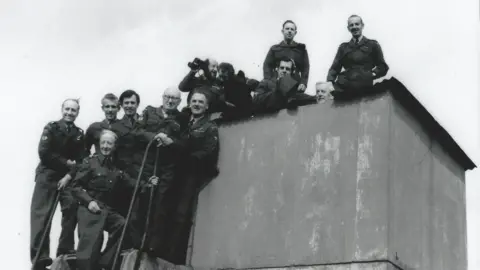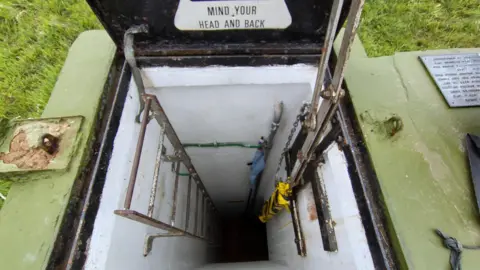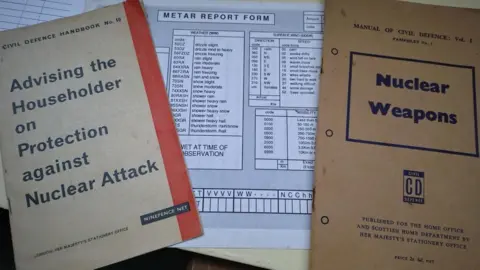The Cold War bunker brought back to life
 Cuckfield Museum
Cuckfield MuseumA grassy field in West Sussex does not give much away about its 100-year military history – above ground at least.
But the site in Cuckfield, butting up against the churchyard of Holy Trinity Church, has had a Royal Observer Corps presence since 1925 and is home to an underground bunker dating back to the early 1960s.
The initial role of the Corps, who were often local volunteers, was to spot enemy aircraft over Britain.
Their work evolved through World War Two and into the Cold War era when they monitored potential nuclear attacks at more than 1,500 listening posts across the country.
'Forgotten in the landscape'
"Not a lot of people seemed to know about it. Yet nearly every village had one of these [posts]," said Ed Rippingale-Combes, who began restoring the underground room in 2008 with his friend Mark Russell.
There were an "enormous amount of these little posts dotted around the place, forgotten in the landscape," he added.
Passionate about history, Ed told Secret Sussex how he and Mark had wanted to restore the bunker to "preserve the memory" of the Cold War, the period between 1945 to 1990 when the US and the Soviet Union vied for ideological, political and military dominance.
"It's a really fascinating look back into the geopolitical and the social psyche of the time," he said.
He noted "how worried we were" about the threat of nuclear war at that time.
Ed pointed to pamphlets on display in the room containing practical advice for surviving a nuclear war, including filling a bath with drinking water and shelter building.

Ed said the concrete bunker was a "real, real mess" when the pair first started work.
Paint was flaking off the walls, the doors were covered in mould and it was filled with three inches of water, as it had been left exposed to the elements for many years.
Open days have been held over several years, but many local people are still surprised to find out about its existence, he added.
"Unless you're looking in the right direction even nowadays you just can't see it."

Work is under way to open up the room again in July and August 2025, when the souvenirs and equipment from almost a century ago are reinstated in the bunker for the few days that it is opened to the public.
Ed said he believed, though it was a "relic of a bygone age now", the room was a tangible way to connect back to a significant period of our recent history.
He said he wanted to capture the feeling that "observers have possibly just popped outside for whatever reason and never came back."
"I think actually we've managed to achieve that," he added.
Follow BBC Sussex on Facebook, on X, and on Instagram. Send your story ideas to [email protected] or WhatsApp us on 08081 002250.
